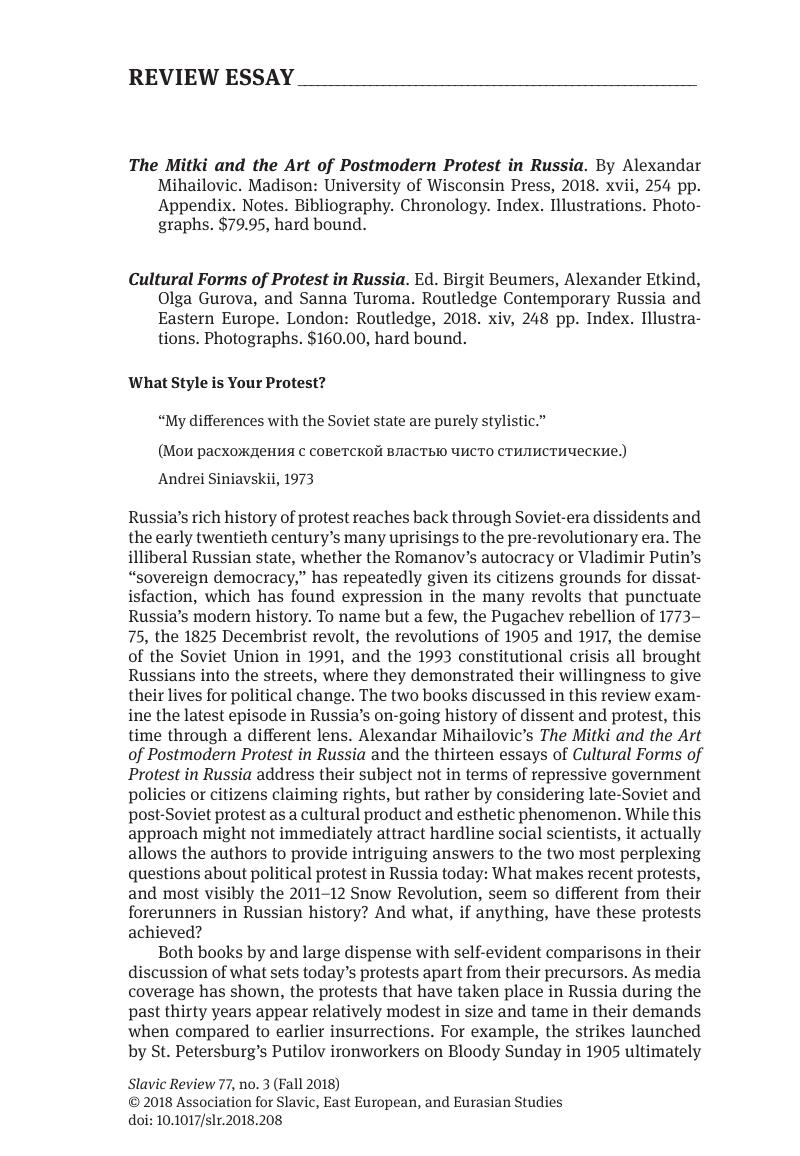No CrossRef data available.
Published online by Cambridge University Press: 25 October 2018

1. Yurchak, Alexei, Everything Was Forever, Until It Was No More: The Last Soviet Generation (Princeton, 2006), 239–43Google Scholar.
2. Makarychev, Andrey and Medvedev, Sergei, “Biopolitics and Power in Putin’s Russia,” Problems of Post-Communism 62/1 (2015): 45–54CrossRefGoogle Scholar.
3. Kalinin builds his argument in part on Il΄ia Budraitskis’s analysis of the Russian intelligentsia as style; see Budraitskis, Il΄ia, “Intelligentsiia kak stil’,” Khudozhestvennyi zhurnal 91 (2013)Google Scholar at http://moscowartmagazine.com/issue/5/article/31 (last accessed 20 May 2018).
4. Lotman, Iu.M., “Arkhaisty—prosvetiteli,” Tynianovskii sbornik: Vtorye tynianovskie chteniia (Riga, 1986), 192–207Google Scholar.
5. For Lotman’s interpretation of Radishchev’s suicide as an instance of self-inflicted martyrdom, see Lotman, Iu.M., “Poetika bytovogo povedeniia v russkoi kul΄ture XVIII veka,” Izbrannye stat΄i v trekh tomakh, Tom I: Stat΄i po semiotike i topologii kul΄tury (Tallinn, 1992), 262–67Google Scholar.
6. Lotman, “Arkhaisty—prosvetiteli,” 199–200.
7. Although Siniavskii first coined this aphorism after his 1973 exile to France, it echoes testimony at his and Iulii Daniel΄’s 1966 trial: “Как литературный критик я довольно хорошо представлял вкусы и нормы, распространенные в нашей литературе. В ряде важных пунктов они не совпадали с моими писательскими и литературными вкусами. Особенности моего литературного творчества достаточно отличаются от того, что у нас принято и что у нас пропускают. Отличаются не политикой, а художественным мироощущением,” Siniavskii i Daniel΄ na skam΄e podsudimykh (New York, 1966), 91Google Scholar. (“As a literary critic, I had a pretty good idea of the prevalent tastes and standards in our literature. On a number of important points, they did not coincide with my tastes as a writer. My literary work differs substantially from what is acceptable here. I don’t mean in politics, but in artistic attitudes,”) Hayward, Max, trans., On Trial: The Soviet State versus ‘Abram Tertz’ and ‘Nikolai Arzhak’” (New York, 1966), 122Google Scholar. Siniavskii later recycled the aphorism in a 1982 essay: “у меня с Советской властью вышли в основном эстетические разногласия.” Siniavskii, Andrei, “Dissidentstvo kak lichnyi opyt,” Sintaksis 15 (1986): 132Google Scholar.
8. Ibid.
9. For insightful analysis of the Pussy Riot trial as “an inadvertent sacrifice,” see Bernstein, Anya, “An Inadvertent Sacrifice: Body Politics and Sovereign Power in the Pussy Riot Affair,” Critical Inquiry 40, no. 1 (September 2013): 220–41CrossRefGoogle Scholar.
10. Oushakine, Serguei Alex., “The Terrifying Mimicry of Samizdat,” Public Culture 13, no. 2 (Spring 2001): 191–214CrossRefGoogle Scholar.
11. “‘Nashistka’ Sveta iz Ivanovo,” YouTube (December 6, 2011) at https://www.youtube.com/watch?v=24XBX0Wkmpw&list=PL5aJM3L7BhSyFeZw7A2WoY7UHkcOk8u2G&index=36 (accessed 20 May 2018).
12. “Ul΄ianovskie kursanty—Satisfaction,” YouTube (January 20, 2018) at https://www.youtube.com/watch?v=k7y2ADtBhFc. For the original video of “Satisfaction” by D.J. Benni Bennasi and the initial parody by a group of young men in the British Army, see Benni Benassi, “Satisfaction (Official Video),” YouTube (April 6, 2012) at https://www.youtube.com/watch?v=aZcSCT34H84 and “British Army Soldiers Dancing to Satisfaction (Benni Benassy),” YouTube (February 8, 2013) at https://www.youtube.com/watch?v=ucOhxo9ivg0 (last accessed May 20, 2018).
13. Eliot Borenstein chronicles public reactions to “Satisfaction” in “Boys Just Want to Have Fun: Just How Queer are the ‘Satisfaction’ Videos?,” NYU Jordan Center (February 27, 2018) at http://jordanrussiacenter.org/news/boys-just-want-fun-just-queer-satisfaction-videos/#.WtOzTtPwZ3m (last accessed May 20, 2018).
14. Masha Gessen, “How Russia’s Hilarious, Homoerotic ‘Satisfaction’ Became a Nationwide Meme of Solidarity, The New Yorker (January 22, 2018) at https://www.newyorker.com/news/our-columnists/how-russias-hilarious-homoerotic-satisfaction-became-a-nationwide-meme-of-solidarity (last accessed May 20, 2018).”